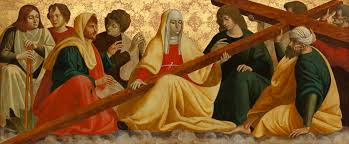The Exaltation of the Cross – so it has been termed in the liturgical revisions after Vatican II – dates back to the time of Constantine, when his mother, Helena, on a pilgrimage to Jerusalem in 326, by apparently miraculous means discovered the wood upon which Christ had been crucified three centuries before. This was one year after the Council of Nicaea, which declared Christ one and for all to be homoousios, ‘consubstantial’ with the Father, God from God, Light from Light, true God from true God, put to death and raised up for our salvation.
This feast also commemorates the triumphal procession of the Cross to the basilica of the Holy Sepulchre in Jerusalem, built by Constantine over the site where it had been found, still the holiest place in the world.
And, finally, today also commemorates the restoration of the Cross to Jerusalem in 629 b Emperor Heraclius, after it had been usurped and carried off by the Persian Emperor Chosroes II in 614.
Legend has it that Constantine had the Cross divided into three parts, a third each for Jerusalem, for Rome (at the Basilica Santa Croce), and the last third to Constantinople, for protection against invaders. Of course, slivers of the Cross have been sent around the world as holy relics, the very wood soaked with the Blood of the Redemptor Mundi. We have been blessed with one here at the College, which will be brought out for veneration at Holy Mass this morning, and I will remember your intentions.
We adore Thee, O Christ, and we bless Thee, for by Thy Holy Cross Thou has redeemed the world.
O Crux ave, spes unica,
hoc Passionis tempore!
piis adauge gratiam,
reisque dele crimina.
O hail the cross our only hope
in this passiontide
grant increase of grace to believers
and remove the sins of the guilty.

